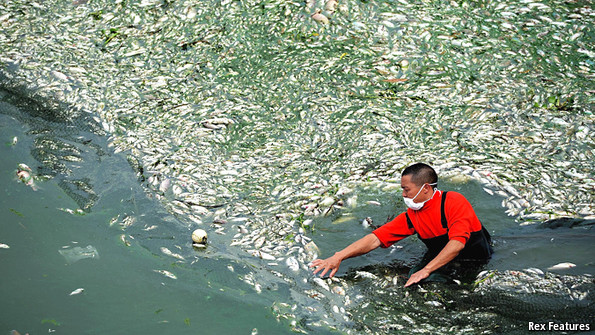The Economist highlights water pollution, disappearing rivers and U.N. standard-shattering water scarcity in China, and argues that the country cannot build its way out of its severe water shortages.
China clearly needs to do something—but not the South-North diversion project. Aside from the massive cost, the two rivers involved have very different ecosystems and taking water from one to the other could do irreparable environmental harm. The bits that have been finished already have killed many organisms. China’s vast engineering projects could also hurt its neighbours. The diversion scheme is just one of several proposals for the rivers of southern China, including the upper reaches of the Brahmaputra and Mekong, which could affect a billion people who live downstream. And all those projects would increase the amount of water in China by only a few percentage points.
The government is approaching the water problem from the wrong end. Damming or diverting rivers tackles only supply—increasing available water by capturing more of what flows through rivers or by moving water from one river to another. The government would do better to focus on demand, reducing consumption of water in order to make better use of limited supplies. Water is too cheap in most cities, usually costing a tenth of prices in Europe. Such mispricing results in extravagance. Industry recycles too little water; agriculture wastes too much. Higher water prices would raise costs for farms and factories, but that would be better than spending billions on shipping water round the country. [Source]
The Economist recently examined the “hydro-industrial complex” behind China’s preference for construction over conservation, both of water itself and of the forests and wetlands that naturally regulate it. In any case, increasingly common droughts in southern China threaten to undermine the basic assumptions on which the South-North diversion project rests. Read more on the project via CDT.
A second article this week describes geological research into the changing courses of the Yangtze and other great rivers that flow from Tibet. At The Hindu, Ananth Krishnan reports international contention over the prospect of further, artificial alterations:
Even as China goes ahead with the construction of four hydropower dams on the Brahmaputra, a Chinese scholar at an influential State-run think-tank has accused the Indian government of attempting to “pressure China” on the issue by seeking “sympathy from the international community”.
[…] “New Delhi has been critical of China in the upper stream by protesting against this imaginary enemy and trying to gain sympathy and support from the international community, but it has totally disregarded the interests of Bangladesh in the lower reaches through its own exploitative usage,” he said. [Source]







